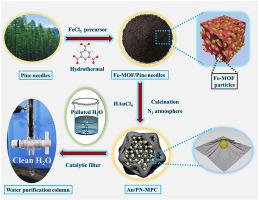Journal of Cleaner Production ( IF 9.7 ) Pub Date : 2020-08-05 , DOI: 10.1016/j.jclepro.2020.123575 Desheng Liu , Xiaochun Li , Junjun Ma , Minna Li , Fujun Ren , Lincheng Zhou

|
Pine needles (PNs) were used as a biomass precursor to fabricate N, O-doped magnetic porous carbon frameworks (PN−MPC) after modification with metal-organic frameworks (MOFs) and carbonization. And PN−MPC catalysts embedded with Au nanoparticles (Au/PN−MPC) were fabricated by a facile two-step route involving impregnation and subsequent thermal reduction procedures. The crystal structures, morphologies, chemical component, and microstructure of the Au/PN−MPC catalysts were initially investigated through various physicochemical characterization. Au/PN−MPC900 exhibited outstanding catalytic activity toward tetracycline (TC) degradation in the presence of H2O2, with a degradation efficiency and degradation rate constant of 96 % and 0.133 min-1 within initial 10 min, respectively. The effects of operating parameters, including initial pH, temperature, catalyst dosage, initial concentrations of TC, and H2O2 concentration on TC degradation were comprehensively investigated. The superior mineralization performance and pH tolerance abilities and catalytic stability of Au/PN−MPC900 were also discussed. After seven consecutive cycles, the removal efficiency of Au/PN−MPC900 for TC degradation was not only greater than 82 %, but also exhibited excellent reusability performance. Furthermore, ·OH radicals were confirmed as the dominant reactive species roles for the degradation of antibiotic pollutants through EPR and ·OH−trapping fluorescence spectral tests, and a plausible catalytic degradation mechanism was proposed. Correspondingly, several possible degradation pathways of TC were tentatively proposed on the basis of the degradation intermediates identified by HPLC-MS measurements. Overall, this novel biomass-derived magnetic porous carbon material embedded with Au nanoparticles is highly promising for many applications, especially in the field of environmental remediation.
中文翻译:

金属有机骨架修饰的松针衍生的N,O掺杂的掺杂Au纳米粒子的磁性多孔碳对四环素的吸附和催化降解
松针(PNs)用作生物质前体,以金属有机骨架(MOFs)改性并碳化后,制造N,O掺杂的磁性多孔碳骨架(PN-MPC)。并通过包括浸渍和随后的热还原步骤在内的简便的两步路线制备了嵌入金纳米颗粒的PN-MPC催化剂(Au / PN-MPC)。最初通过各种理化特性研究了Au / PN-MPC催化剂的晶体结构,形态,化学成分和微观结构。Au / PN-MPC900在H 2 O 2存在下对四环素(TC)降解表现出优异的催化活性,降解效率和降解速率常数分别为96%和0.133 min -1分别在最初的10分钟内。操作参数的影响,包括初始pH,温度,催化剂用量,TC的初始浓度和H 2 O 2浓度对TC降解进行了全面研究。还讨论了Au / PN-MPC900优异的矿化性能,pH耐受能力和催化稳定性。连续七个循环后,Au / PN-MPC900去除TC的效率不仅大于82%,而且还具有出色的可重复使用性。此外,通过EPR和·OH-捕获荧光光谱测试,确定了·OH自由基是降解抗生素污染物的主要反应物种,并提出了可能的催化降解机理。相应地,在通过HPLC-MS测量鉴定的降解中间体的基础上,初步提出了几种可能的TC降解途径。总体,











































 京公网安备 11010802027423号
京公网安备 11010802027423号